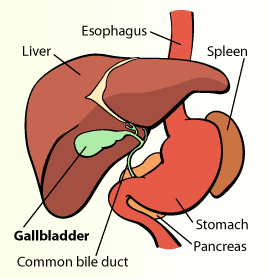Cholecystectomy (Pediatric)
 A cholecystectomy is an operation to remove the gallbladder. The gallbladder is a small sac found just under the liver, on the right side of the abdomen. The gallbladder stores a liquid called bile. Bile is made in the liver and released into the intestine with meals. Bile is important because it helps digest the fat in foods.
A cholecystectomy is an operation to remove the gallbladder. The gallbladder is a small sac found just under the liver, on the right side of the abdomen. The gallbladder stores a liquid called bile. Bile is made in the liver and released into the intestine with meals. Bile is important because it helps digest the fat in foods.
The gallbladder is not an essential organ and your child will do well after cholecystectomy. Once the gallbladder is removed, bile will continue to be released from the liver directly into the intestine with meals.
How are gallstones diagnosed?
The presence of gallstones can be documented by ultrasound study. This may be ordered by your child's primary care practitioner. The pediatric surgeon will need to review this study in the office, at the time of your child's appointment. You will need to bring all studies into your office appointment.
Why is cholecystectomy necessary?
The primary reason for cholecystectomy is gallstones and pain. Gallstones are small rocks that form inside the gallbladder. Gallstones can block the release of bile out of the gallbladder. This blockage can cause pain and jaundice (yellow skin color). If your child has these problems his or her primary care doctor or nurse may recommend a visit with a pediatric surgeon. Because gallstones cannot be removed without taking out the gallbladder both the stones and the gallbladder are removed at the time of the operation.
How will a cholecystectomy be performed?
A large incision may not be required. In most cases, a cholecystectomy can be performed laparoscopically using a small telescope and tiny instruments placed through band-aid sized incisions on the abdomen. The operation is usually completed in one to two hours. During hospitalization, your child will receive intravenous fluids, antibiotics and pain medication. As soon as your child feels well enough he/ she will be allowed to eat, drink and take pain medication by mouth, often as early as the evening of surgery.
In most cholecystectomy operations, there is very little blood loss. your child will receive blood only in the rare case of an extreme emergency. If you wish to provide a directed donation of blood, contact our office, 1-2 weeks in advance of the operation.
How long will my child remain in the hospital after the operation?
Your child must be able to eat, drink and be comfortable on pain medication taken by mouth before going home. Most children are ready to go home in one to two days after the operation.
Your child must be able to eat, drink and be comfortable on pain medication taken by mouth before going home. Most children are ready to go home in one to two days after the operation.
Homecare After Surgery
Pain Management
Prescription pain medication is not routinely required after hospital discharge. Most children only need Acetaminophen (Tylenol®) or Ibuprophen (Motrin®) once they are at home. Follow the dosage directions on the label. If your child is still uncomfortable, call our office and we may prescribe something stronger.
Care for Dressings
Gauze and clear plastic dressings, placed over the incisions, may be removed two days after surgery. Over the incision, there will be pieces of tape called Steri-strips®. On the Steri-strips®, there may be a small amount of blood. This is normal. Your child can bathe with the Steri-strips® in place. These can be removed one week after the operation. The skin surrounding the incision may be red and bruised, and the incision may be slightly swollen. This can last several weeks. There will be no visible stitches to remove because they are under the skin. The stitches will dissolve after several weeks.
In most operations, the wound is closed with dissolvable suture (stitches). These stitches are under the skin and do not have to be removed. In some children these stitches may come through the incision about 4 weeks postoperatively. This may be associated with a little local redness and pus and it may involve an end of the incision or a larger portion. This is normal and is best treated by gently cleansing the area with soap and water and waiting. When the suture falls out or completely dissolves, the wound will heal. If your child has worsening redness, swelling pain of the incision and a fever within 2weeks of the operation, please call our office.
Healing Ridge
After the incisions are healed you will be able to feel a firm ridge just underneath. This is called a healing ridge and it is normal to find this after surgery. The healing ridge usually lasts for several months before it softens and disappears.
Bathing Restrictions
Your child may bathe or shower as soon as two days after surgery. Once your child is feeling better, before discharge or at home, he or she may bathe or shower without restriction.
Activity Restrictions
There are no specific activity restrictions following surgery. Your child can return to school as soon as he or she feels well enough. If you need a letter sent to your child's school regarding the operation and recovery, please contact our office.
If all is going well, a visit to our office is not required. Our pediatric nurse practitioner will call you to check on your child's recovery. A visit with your child's pediatrician one to two weeks after the discharge is recommended.
When do I call the surgeon's office?
Call our office at 415-476-2538 for the following:
- Any concerns you have about your child's recovery
- A temperature of 101°F or higher
- A red incision
- Increasing pain and tenderness at the incision
- Any liquid coming out of the incision
